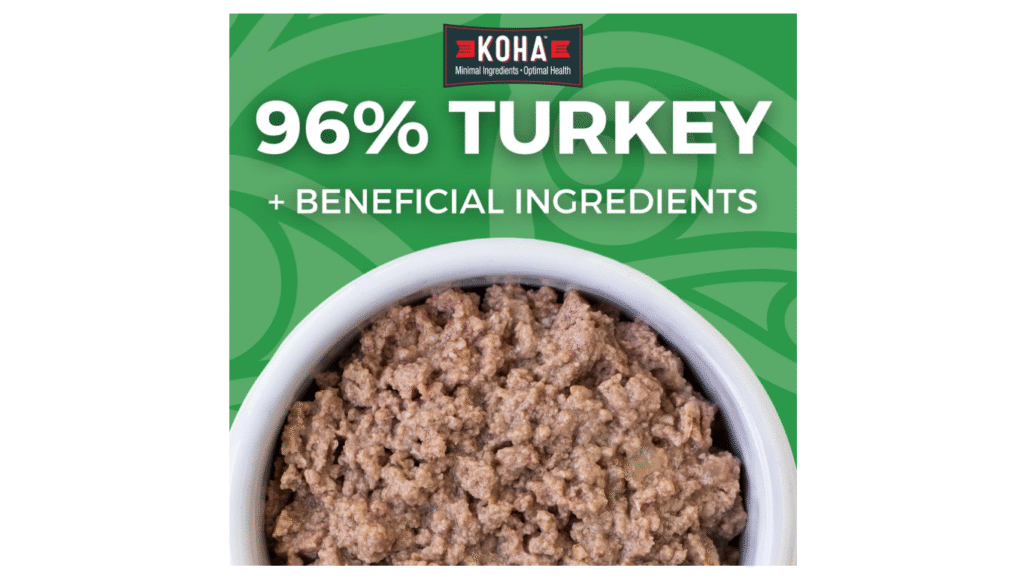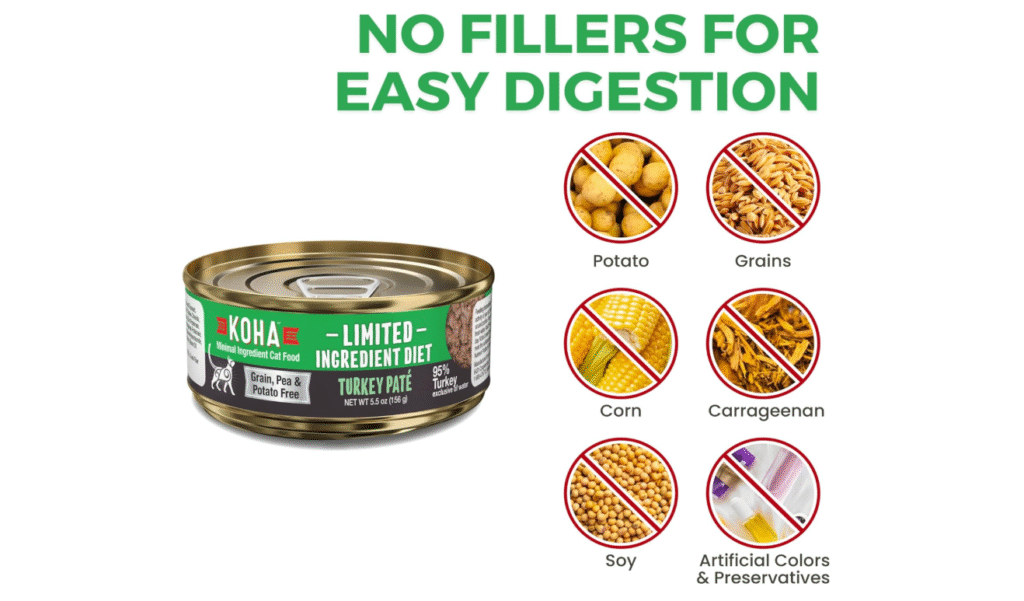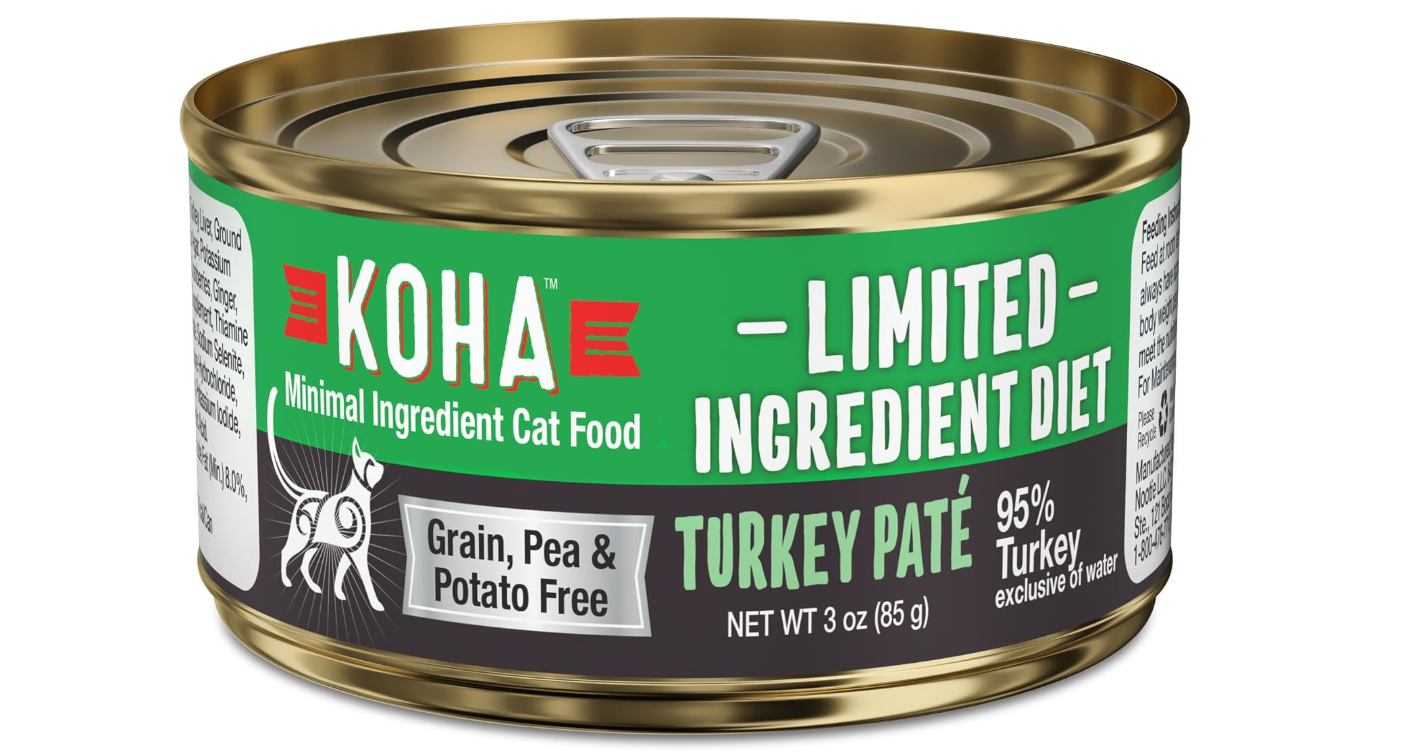Here’s the truth: feeding your cat shouldn’t feel like decoding a food label in a foreign language. But it often does. Between flashy claims, “vet recommended” badges, and ingredient lists that read like a chemistry set… knowing what’s actually good for your cat can feel impossibly murky.
That’s where Koha Cat Food enters the chat — promising simple, clean, species-appropriate nutrition. But does it actually deliver? Or is it just another boutique brand cashing in on wellness trends?
In this review, we’re going all in — no fluff, no jargon. Just straight talk about Koha’s origins, ingredient integrity, product range, and how it stacks up against your other go-to brands. We’ll look at what picky cats actually think, how sensitive stomachs respond, and whether it’s worth the premium price tag.
Whether you’re dealing with a finicky eater, a cat with allergies, or you’re just trying to level up your furry friend’s nutrition — this review is built for you. Let’s break it all down, one bowl at a time.
Table of Contents
Koha Cat Food: Where It Comes From and What They Stand For

You might not think about the people behind your cat’s food — but you should. Because in an industry where vague sourcing and shadowy manufacturers are the norm, Koha stands out by making transparency part of its DNA.
The Story Behind the Brand
Koha was born from frustration — the kind of deep, personal frustration that comes when your pet is suffering and nothing on the market seems to help. The founder’s own cat struggled with chronic digestive issues, and traditional pet foods only made things worse. That experience led to a bold idea: what if cat food could be radically simple and radically clean?
Launched in 2014, Koha (which means “gift” in Māori) is based in the U.S. but manufactures its food in premium facilities in Canada, Thailand, and the U.S., depending on the product. Why those places? Each was selected based on strict food safety standards, reputation for quality, and the ability to source human-grade ingredients.
What Makes Koha Different?
Unlike many pet food companies that mask fillers and byproducts behind fluffy marketing language, Koha leans into minimalism. No peas. No potatoes. No grains. And definitely no artificial junk. Most recipes use a single protein source, making them a go-to for cats with allergies or sensitive guts.
But here’s the kicker — they don’t just say it’s clean. They actually show it. Full ingredient disclosures, no hidden “meals,” and manufacturing partnerships with facilities that also handle human food. That’s a trust signal not every brand can claim.
Koha also avoids mass-market compromises. You won’t find their food lining big-box pet aisles. It’s niche, focused, and designed for pet parents who care hard about what’s in the bowl.
Who Is Koha Really For?
- Cats with food sensitivities or digestive issues
- Owners seeking limited-ingredient or novel-protein diets
- People willing to spend more for quality and transparency
- Those tired of navigating ingredient lists that feel like bait-and-switches
FAQ – Is Koha Cat Food Made in the USA?
Yes and no. Koha is a U.S.-based company, but its manufacturing depends on the product line:
- Their “Limited Ingredient” and “Pure Shreds” are made in Canada and Thailand (respectively),
- Some freeze-dried toppers and broths are made in the U.S.
Each factory is chosen for its ability to meet Koha’s standards of safety, sourcing, and quality.
Koha’s Cat Food Lineup: What They Offer and Why It Matters

Not all cat foods are created equal — and Koha doesn’t pretend otherwise. Instead of a bloated catalog of indistinguishable flavors, they’ve carved out a niche with thoughtfully curated options that serve real dietary needs.
Whether your cat needs help with digestion, allergies, or just prefers a certain texture, Koha’s product lineup is all about choice with purpose. Let’s unpack what’s actually on the shelf.
Limited Ingredient Diets – The Gut-First Formula
If your cat has a sensitive stomach, chances are you’ve already tried switching foods. Koha’s Limited Ingredient Diet (LID) line is built exactly for that scenario. Each recipe features:
- One novel protein (like rabbit, duck, or kangaroo)
- No fillers, grains, or potatoes
- Rich broth base to support hydration and kidney health
It’s the kind of food that skips everything that doesn’t serve your cat — no second-guessing. And let’s be honest: when your cat stops vomiting or itching, that clarity is worth every dollar.
H3: Pure Shreds – For the Texture-Obsessed Cat
You know the type — the cat who snubs pâté like it’s beneath them. Koha’s Pure Shreds line is a feast for texture lovers. Think:
- Hand-shredded proteins in a rich broth
- Ultra-high moisture content
- Ultra-low carbs
It’s especially useful for picky eaters and older cats who need a softer, more palatable texture. Also great for keeping water intake up — something most cats struggle with silently.
Minimalist Pâté – Basic, But Not Boring
This line is the backbone of Koha’s wet food offerings. Simple recipes, ultra-smooth texture, and available in proteins like turkey, chicken, beef, and duck. Key features:
- Gently processed to preserve nutrients
- No pea protein or soy
- Budget-friendlier than Pure Shreds, without quality loss
For cats who like their food smooth and their diet clean, this line quietly delivers.
Functional Toppers & Hydration Boosters
Beyond full meals, Koha offers supplemental products designed to support specific health concerns:
- Lamb Green Tripe Topper – great for gut health and picky eaters
- Bone Broth Pouches – hydrating and rich in minerals
- Freeze-Dried Raw Toppers – extra protein punch and texture
These aren’t just gimmicks — they’re designed for real problems like dehydration, appetite loss, and digestive imbalance.
FAQ – Which Koha Line Is Best for Cats with Allergies?
Start with the Limited Ingredient Diet line. Choose a novel protein your cat hasn’t eaten before (like rabbit or kangaroo). These recipes are grain-free, pea-free, and ideal for elimination diets or long-term maintenance if your cat has chronic food intolerances.
What’s Inside Koha Cat Food? A Deep Dive Into Nutrition & Ingredients
If you’ve ever stared at a pet food label and wondered, “Okay, but is this actually good for my cat?” — you’re not alone. In a market bloated with meaningless buzzwords (“natural,” “premium,” “ancestral”), Koha’s simplicity feels oddly radical.
Let’s break down what their nutrition really looks like, beyond the label.
The Protein-First Philosophy
Every Koha recipe — and we mean every one — puts protein first. And not just any protein. We’re talking clean muscle meats like duck, rabbit, turkey, and beef, not ambiguous “meat meals” or rendered leftovers.
- Muscle meat as the #1 ingredient: This is what obligate carnivores like cats actually need.
- Single-protein focus: Ideal for cats with food intolerances or allergies.
- No plant proteins as fillers: You won’t find soy, lentils, or pea protein boosting the crude protein levels artificially.
This kind of formulation does two things:
- It mirrors what a cat’s natural diet would look like in the wild.
- It reduces the risk of dietary inflammation and digestive issues long-term.
Moisture Matters (A Lot)
Koha’s wet foods clock in at 75–82% moisture — far above most kibble and even many other canned foods. This isn’t just a hydration bonus. It’s a preventive strategy.
Chronic dehydration in cats is linked to:
- Kidney disease
- Urinary tract infections
- Constipation
So, if your cat is “bad at drinking water,” high-moisture foods like Koha’s aren’t optional — they’re a fix in disguise.
The No-Nonsense Ingredient List
Here’s what you won’t find in Koha:
- Peas
- Potatoes
- Corn
- Wheat
- Carrageenan
- Artificial colors or preservatives
What you will find:
- Named animal proteins
- Organ meats like liver (hello, natural vitamins)
- Functional broth bases
- Occasional functional extras like pumpkin or cranberries (depending on the line)
And just to be clear: when they say “no fillers,” they mean it. There’s no sneaky “pea fiber” or tapioca thickener hiding in the fine print.

What Real Customers Say About Koha Cat Food: Hits, Misses & Meow Moments
At some point, all the ingredient talk and manufacturing facts blur together — and what really matters is: does my cat eat it, and does it help?
To answer that, we turned to the real-world voices: customers who’ve actually fed Koha to their feline companions. The results? Surprisingly human — full of relief, trial-and-error stories, and, yes, a few honest gripes.
The Rave Reviews – What People Love/ koha cat food
Across forums, retail sites, and review hubs, a few consistent themes emerge:
- Digestive miracles: Countless cat parents report relief from chronic vomiting, diarrhea, or constipation within days of switching.
- Picky eater goldmine: Especially the Pure Shreds and Tripe toppers — these are cat-pleasers for animals who’ve ghosted other foods.
- Visible health improvements: Softer coats, fewer hairballs, and better litter box outcomes are frequent wins.
Customer Snapshot: koha cat food
“We were on our fifth brand trying to find something our IBS-prone senior cat could handle. Koha Rabbit LID was the first food that didn’t cause a flare-up. Total game changer.”
— ★★★★★, Chewy review
Another one: koha cat food
“My cat turns her nose up at everything — but she licked the bowl clean with Koha’s Chicken Pure Shreds. That NEVER happens.”
— ★★★★★, Reddit user r/cats
H3: The Honest Complaints – What Doesn’t Work for Everyone
Of course, no product is universally loved — and Koha has its share of downsides:
- Inconsistent availability: Some flavors are hard to find, especially in local stores.
- Price pain: It’s not the cheapest option — especially for multi-cat households.
- Texture quirks: The pâté can be a little dry for cats who like saucy textures (easily fixed by adding broth).
Customer Snapshot:
“The food is fantastic quality, but honestly? The price adds up fast with two cats. I wish they offered a larger can size or bundle savings.”
— ★★★☆☆, Amazon reviewer
koha cat food vs. The Competition: Is It Really Better Than Other Premium Cat Foods?
When you’re in the pet food aisle (or more likely, scrolling late at night), you’ve probably seen the same few names come up again and again: Weruva, Tiki Cat, Wellness, Instinct. So where does Koha land in that crowded premium space?
The short version? It punches well above its weight — but it’s not the best choice for everyone. Let’s compare it head-to-head with some of the big players.
koha cat food vs. Tiki Cat
What’s similar:
- Both are high-moisture, protein-rich, and grain-free.
- Both offer shredded and pâté styles.
What’s different:
- Koha emphasizes limited ingredients and novel proteins; Tiki Cat often includes fish and more exotic combos.
- Koha avoids peas, potatoes, and any plant fillers entirely — Tiki occasionally includes them.
- Tiki Cat tends to be more affordable and widely available.
Verdict:
Koha wins on simplicity and sensitivity. Tiki Cat wins on price and variety.
koha cat food vs. Weruva
What’s similar:
- Both prioritize clean ingredients, high moisture, and transparency.
What’s different:
- Weruva leans heavily into fish-based recipes; Koha minimizes fish to reduce mercury concerns.
- Koha’s LID approach is more targeted toward allergy-prone cats.
- Weruva can be a bit more flavorful due to higher fat content.
Verdict:
Weruva is flashier — Koha is cleaner. Choose Koha if your cat has dietary issues; Weruva if your cat’s just fussy and healthy.
koha cat food vs. Wellness CORE
What’s similar:
- Both offer grain-free, protein-forward foods with a focus on health outcomes.
What’s different:
- Wellness still uses peas and potatoes in some lines.
- Koha focuses exclusively on wet food and toppers, while Wellness offers kibble and treats too.
Verdict:
Koha offers tighter formulation control. Wellness is more versatile but not as minimal.
Who Shouldn’t Choose Koha?
Let’s be honest: Koha’s not for budget-first shoppers. And if your cat thrives on big-name brands and eats anything without a fuss? You may not need the LID precision Koha offers.
But if you:
- Have a cat with allergies or IBD
- Want transparent sourcing and limited ingredients
- Prefer wet food and hydration-focused diets
…then Koha should absolutely be on your radar.
How to Feed Koha Cat Food: Guidelines, Tips & Transition Advice
So, you’ve got the cans. Your cat’s staring at you with a mix of hope and suspicion. Now what?
Feeding Koha isn’t just a matter of opening a can and hoping for the best. Because it’s more nutrient-dense and moisture-rich than many commercial foods, a thoughtful approach can make all the difference — especially if you’re switching from kibble or a carb-heavy diet.
Let’s break it down so you’re not guessing.
How Much koha cat food to Feed Per Day?
Koha recommends:
- Approximately 1 can (5.5 oz) per 6–8 lbs of body weight per day
Split that into 2–3 meals for optimal digestion and satiety.
But let’s reality-check that. If your cat:
- Is particularly active or underweight → increase by 10–20%
- Is older, sedentary, or overweight → decrease slightly and monitor weight weekly
Koha’s nutrient density is higher than grocery store brands, so many owners report needing less than expected to maintain weight.
Transitioning to Koha – Do It Slowly
Your cat’s gut is a creature of habit. Even if you’re upgrading to better ingredients, a sudden switch can lead to stomach upsets or outright rejection.
Here’s the 7-day Koha transition plan:
- Day 1–2: 75% old food + 25% Koha
- Day 3–4: 50/50 mix
- Day 5–6: 25% old food + 75% Koha
- Day 7+: 100% Koha
Pro tip: Warm it up slightly (10 seconds in the microwave) to boost aroma and entice picky eaters.
H3: Feeding Special Cases
- Senior Cats: Koha’s broths and Pure Shreds are excellent for older cats with dental or hydration challenges.
- Kittens: Koha is not labeled “all life stages” across the board — check specific recipes before feeding kittens. Some are adult-only formulas.
- Medical Diets: Always consult your vet if your cat is on a prescription diet, especially for kidney or urinary issues.
Final Verdict: Is Koha the Right Choice for Your Cat? koha cat food
Feeding your cat shouldn’t feel like an experiment — but if you’re here, it probably has.
You’ve likely tried the supermarket brands. Maybe even a few “premium” options that came highly rated but didn’t sit well. Whether it’s allergies, digestive issues, picky taste buds, or just that vague sense that something’s off, the frustration is real.
koha cat food isn’t magic. But it is different — in ways that matter.
Its limited-ingredient philosophy isn’t a trend grab; it’s a thoughtful solution to a real-world problem: too many cats eating foods designed more for shelf life than species needs. Its formulas aren’t overloaded with fillers or “nutrition by committee.” They’re clean, consistent, and built to nourish from the inside out.
Is it the cheapest food? No.
Will every cat love every recipe? Also no.
But if you’re seeking clarity in the chaos of pet nutrition — something that aligns with how cats are meant to eat — Koha is one of the rare brands that actually walks the walk.
So, if you’re ready to stop guessing and start feeding with confidence, Koha might just be the food your cat — and your peace of mind — has been waiting for.

